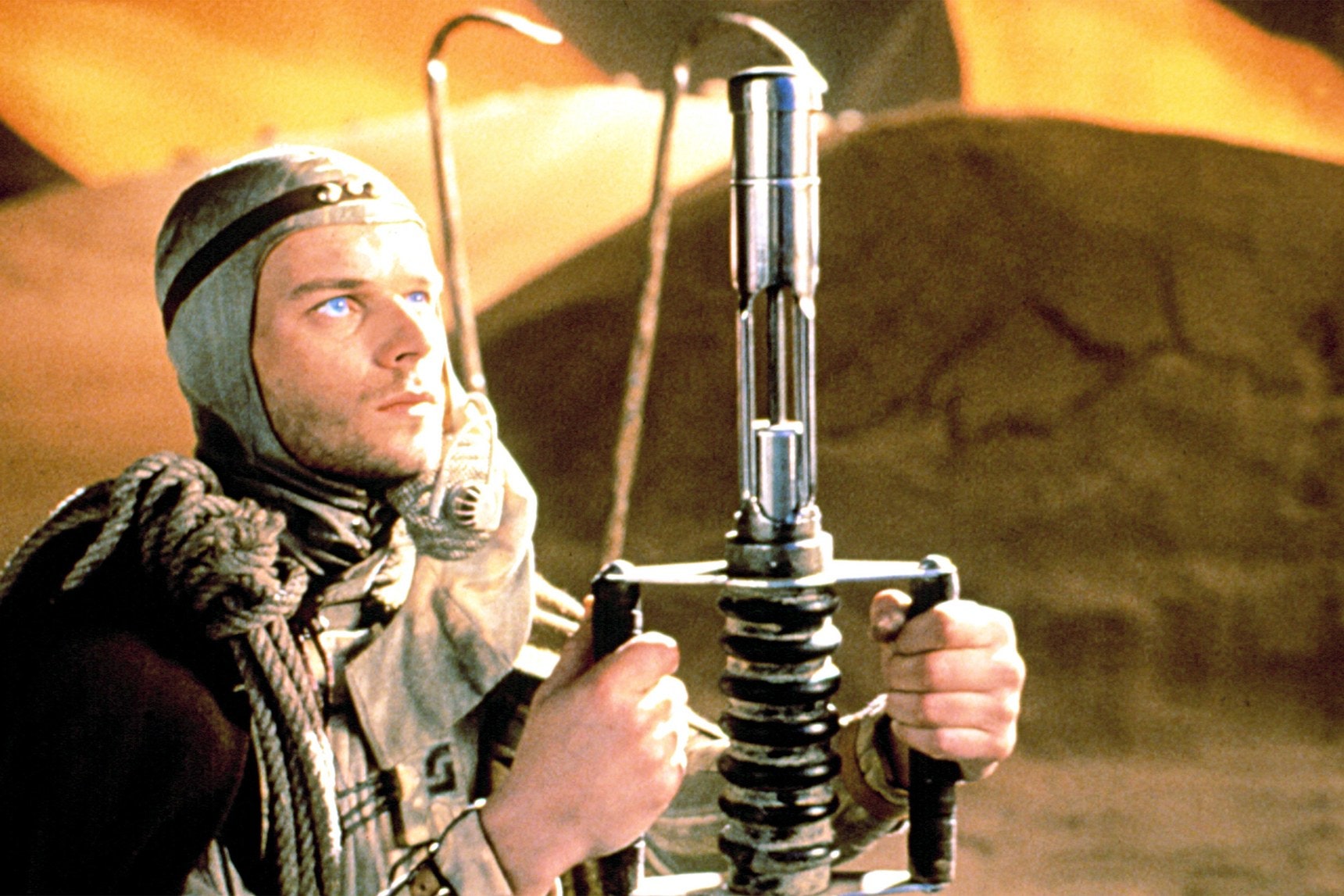Skip Article Header. Skip to: Start of Article.

In December 2000, the Sci-Fi Channel (since renamed Syfy) released Frank Herbert’s Dune, an ambitious three-part miniseries. Science fiction author Rajan Khanna was a recent college grad when he first watched the show.
“I remember it coming out, and I remember honestly the Sci-Fi Channel being a big deal back in the day,” Khanna says in Episode 515 of the Geek’s Guide to the Galaxy podcast. “This was before there was all this geek stuff everywhere. It was sort of like, ‘This is for us,’ in a way.”
With a budget of $20 million, Frank Herbert’s Dune was an ambitious project for the fledgling network. The series won an Emmy for special effects and was one of the channel’s highest-rated programs. But TV writer Andrea Kail warns that modern audiences won’t exactly be blown away by the show’s production values. “I have a very distinct memory of one specific shot where Jessica and Paul are running away from the ornithopters, and they’re running in place in front of a bad green screen,” she says. “It was like watching a play being filmed. It wasn’t a movie, it was a play that somebody pointed a camera at.”
Geek’s Guide to the Galaxy host David Barr Kirtley agrees that the show has its problems, but he enjoyed a subplot involving Princess Irulan, a minor character in the novel who was completely omitted from the recent film. “Dune is a combination of ‘space opera court intrigue’ and ‘hippie Lawrence of Arabia,’” he says. “Those are the two elements. I like the space opera court intrigue stuff significantly more. [Irulan’s] storyline continued the space opera court intrigue stuff through the whole story, so I actually really liked that a lot.”
Science fiction author Matthew Kressel says the quality of the underlying material shines through regardless of any rough edges. In particular he enjoyed how the series captures the texture of the novel. “I love the Villeneuve movie, of course, but it’s a very frenetic film,” he says. “I feel like there was something about this series that took its time telling the story, and I respected that.”
Listen to the complete interview with Rajan Khanna, Andrea Kail, and Matthew Kressel in Episode 515 of Geek’s Guide to the Galaxy (above). And check out some highlights from the discussion below.
Andrea Kail on Frank Herbert’s Dune vs. Dune (1984):
This [miniseries] makes the Lynch version look like the Denis Villeneuve version, and the Lynch version makes the Villeneuve version look like a movie delivered by the hand of God. That’s how much this propped everything else up … The [Lynch version] is a terrible movie, but I will never not watch it if it’s on. It’s a bad movie, but it’s compellingly bad. I always sit and watch it because it’s a spectacle. This? I love Dune, but I will not sit and watch this again. Do you see the difference? The [Lynch version] is visually interesting and there’s a lot going on. This is not something I would ever watch again willingly, and I’m a Dune fanatic.
Matthew Kressel on special effects:
There were some places where they didn’t even do a matte painting, they just had a backdrop that they unrolled behind the actors. That’s an odd choice, because maybe they didn’t have the money for a matte painting, but they certainly had green screens by this point. So I was very curious about that … We’re spoiled by the special effects today. They’re so good, everything looks real. It’s flawless. But we kind of forget that that was really, really hard to achieve. Even Star Wars, which had this huge budget, you watch the original one—not the remaster—and it’s like, “Yeah, the Death Star is a model.” You can just tell on the close-up shots.
David Barr Kirtley on Frank Herbert’s Dune vs. Dune (2021):
The Villeneuve movie basically doesn’t explain anything. “Mentats? Don’t worry about it. Guild Navigators? Don’t worry about it, it’s not important.” It just focuses on telling a compelling, emotional character story. The [miniseries] tries to explain a lot more of the world-building, and that’s really bad in a lot of ways—dramatically—but I feel like if you watch this you actually know more about the world and what happens in the book than you would from watching the Villeneuve movie—which is a million times better, but it’s made a trade-off of dramatic effectiveness versus world-building explication.
Rajan Khanna on adaptation:
I think this [miniseries] is one of the examples of how being faithful to a book can be a trap, because what you end up with is a box-checking exercise and not a lot of life. All of the great adaptations condense things, smush things together, cut things out. Lord of the Rings is widely regarded as an amazing adaptation, and they cut all kinds of things. There’s always somebody who’s like, “Tom Bombadil!” But Tom Bombadil needed to go … You have to make those choices. I think this is an example of being faithful but also being flat and not having a lot of heart or energy. So I would not recommend this for anyone except hardcore Dune historians.
More Great WIRED Stories
- 📩 The latest on tech, science, and more: Get our newsletters!
- The takedown of the web’s biggest child abuse site
- Get ready for a decade of Uranus jokes
- How to use BeReal, the “unfiltered” social media app
- Should all video games be replayable?
- The fake agents case baffling US intelligence experts





